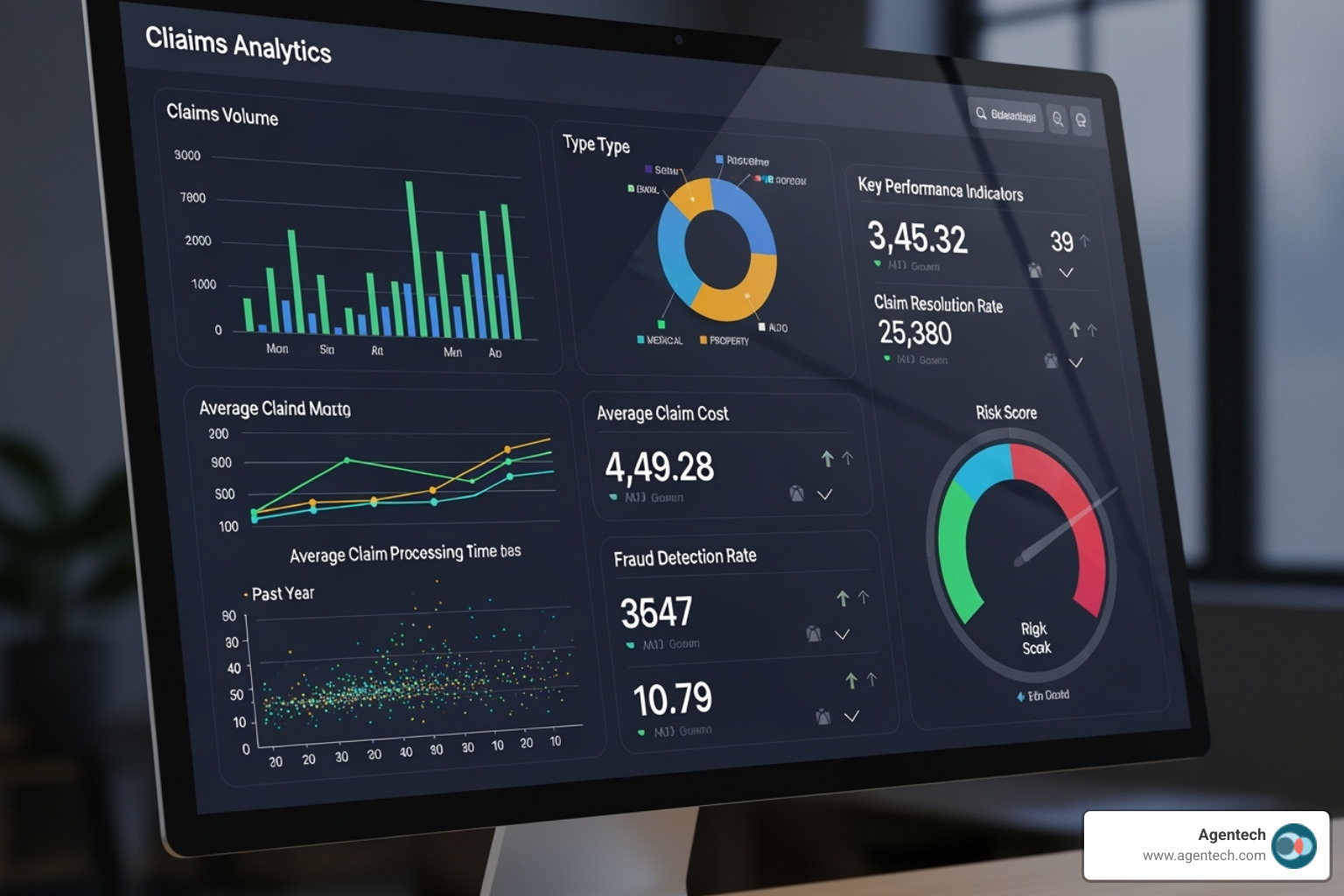Why Claims Analytics is Reshaping the P&C Insurance Landscape
Insurance claims analytics software is changing how P&C carriers, TPAs, and Independent Adjusting firms process claims across residential property, auto, pet, and workers' compensation lines. These platforms use AI and machine learning to analyze claim data, predict outcomes, and automate decisions that traditionally required manual review.
Top Insurance Claims Analytics Software Capabilities:
- Fraud Detection: AI models identify suspicious patterns and can reduce false positives by up to 75%.
- Claims Triage: Automated scoring fast tracks simple claims with high accuracy using Day 1 data.
- Predictive Analytics: Machine learning predicts claim severity, litigation risk, and settlement costs.
- Real time Alerts: Systems flag high risk claims before they escalate into costly problems.
- Document Intelligence: Natural language processing extracts insights from adjuster notes and medical records.
The pressure on claims departments has never been greater. Customer satisfaction expectations are rising while regulatory compliance requirements grow more complex. Manual processes that worked for decades now create bottlenecks that frustrate policyholders and overworked adjusters.
Modern claims analytics software addresses these challenges head-on. Companies using these platforms report significant decreases in claims handling time, sometimes by as much as 66%, and millions in annual fraud savings. Fast, effective claims service has become a key driver of customer satisfaction and policyholder loyalty.
The shift from reactive to proactive claims management represents a fundamental change in how the industry operates. Instead of waiting for problems to surface, analytics software spots issues early and guides adjusters toward optimal outcomes.
As the founder of Agentech AI, I've seen how insurance claims analytics software can transform operations after successfully building and scaling a high-growth technology company before focusing on AI solutions for the P&C insurance sector. My experience has shown me that the right analytics platform can turn claims processing from a cost center into a competitive advantage.
The Core Engine: What Does P&C Insurance Claims Analytics Software Actually Do?
Think of insurance claims analytics software as the brain behind modern P&C claims operations. It takes the chaos of daily claims processing and transforms it into something that makes sense. Instead of drowning in paperwork and guesswork, adjusters and managers get clear insights that help them make better decisions faster.

Data Aggregation and Management
Every claim generates a mountain of information scattered across different systems, from policy details and adjuster notes to photos and third party reports. Insurance claims analytics software acts like a skilled librarian, gathering all these pieces and organizing them into one coherent picture.
The software doesn't just collect obvious data like policy numbers and claim amounts. It also digs into the messy, unstructured data that humans create every day. Those detailed adjuster notes that capture crucial context? The software reads and understands them using natural language processing. Customer emails, repair estimates, and medical reports all get processed and analyzed for valuable insights that might otherwise slip through the cracks.
What makes this really powerful is the scale of data these systems can tap into. Industry databases contain information from billions of claims across the P&C insurance landscape. This means your residential property, auto, pet, or workers' compensation claims benefit from patterns learned across the entire industry, resulting in a much richer understanding of each claim.
The goal isn't just to hoard data; it's about creating data quality that enables smarter decisions. When information is clean, organized, and easily accessible, everything else becomes possible. This foundation is what makes AI claims processing systems so effective at automating routine tasks while keeping humans in control of important decisions.
Predictive Analytics and Scoring
This is where the software moves from reporting what happened to predicting what will happen next, turning organized data into dividends through insurance claims machine learning.
Claim severity prediction helps you understand early on whether you're dealing with a minor fender bender or a major loss. The software looks at patterns from similar claims and gives you a realistic picture of where things are headed. This means no more surprises three months down the road when a seemingly simple claim turns complicated.
Litigation risk scoring is another game changer. By analyzing historical patterns, the software can flag claims that have characteristics similar to those that ended up in court. This early warning gives you time to take proactive steps that might prevent litigation altogether, saving both money and headaches.
Fraud detection might be the most impressive capability of all. The software can spot suspicious patterns that would take human investigators weeks to uncover. It reduces false positives dramatically, so your team can focus their energy on the claims that actually deserve closer scrutiny.
Automated claim triage sorts incoming claims into the right buckets from day one. Simple, straightforward claims get fast tracked for quick resolution. Complex or high risk claims get the attention they deserve. This means faster service for your policyholders and better use of your adjusters' time.
Real-Time Dashboards and Reporting
All this intelligence needs to reach the right people at the right time. That's where intuitive dashboards come in. Think of them as mission control for your claims operation, where everything important is visible at a glance, and you can drill down when you need details.
KPI tracking becomes effortless when the software automatically monitors cycle times, loss adjustment expenses, and customer satisfaction scores. You can see trends as they develop and make adjustments before small problems become big ones.
Performance benchmarking helps you understand how your operation compares to industry standards. Are your cycle times competitive? Are your costs in line? The software gives you context that helps you set realistic goals and celebrate real improvements.
Visual insights turn complex data into clear pictures. Heat maps can show where fraud risks are highest. Trend charts reveal seasonal patterns in your book of business. Operational dashboards help you balance adjuster workloads and spot bottlenecks before they slow everything down.
Cycle time monitoring tracks claims from first notice of loss all the way to settlement. This visibility helps you identify exactly where delays happen and take action to speed things up. Since fast, fair claim resolution is the biggest driver of customer satisfaction, this capability directly impacts your bottom line.
The beauty of modern insurance claims analytics software is that it puts all this power at your fingertips without requiring a PhD in data science. The insights are clear, the recommendations are actionable, and the results speak for themselves.
Opening up Major Benefits: From Cost Reduction to Customer Loyalty
The real magic of insurance claims analytics software happens when the technology starts delivering measurable results that transform your entire operation. For P&C carriers, TPAs, and Independent Adjusting firms, these platforms not only modernize processes but also fundamentally change the economics of claims management while creating happier policyholders.
Driving Operational Efficiency and Reducing Costs
When claims departments start using analytics software, the efficiency gains are often dramatic. The most impressive results come from automating the routine work that typically bogs down adjusters and creates bottlenecks in the claims process.
Companies implementing these solutions regularly see dramatic decreases in claims handling time across their operations. This isn't just about working fasterit's about working smarter. Simple claims that once required manual review can now be processed automatically with remarkable accuracy, freeing up experienced adjusters to focus on complex cases that truly need human expertise.
The financial impact shows up clearly in Loss Adjustment Expenses (LAE). Organizations report significant reductions in LAE and daily drivetime for field adjusters. When you can optimize adjuster assignments and reduce unnecessary travel, the cost savings compound quickly across your entire claims operation.
Automated triage becomes a game changer for workload management. Instead of claims sitting in queues waiting for manual assignment, analytics software instantly routes each claim to the most appropriate resource. Complex workers' compensation cases go to specialists, while straightforward auto claims can be fast tracked through streamlined processes. This optimization means your team is always working on the right cases at the right time.
The speed improvements are remarkable too. Some platforms deliver claims processing that is significantly faster than traditional methods, with AI enabled first notice of loss reducing claim reporting times substantially. During catastrophic events affecting residential property claims, this speed can mean the difference between managing a crisis and drowning in it.
For more insights on how automation transforms back office operations, explore our guide on insurance back office automation.
Enhancing the Policyholder Experience
Here's where insurance claims analytics software really proves its worth: turning frustrated policyholders into loyal advocates. In the competitive P&C insurance market, claims experience often determines whether customers renew their policies or switch to competitors.
The numbers tell a compelling story. Companies using claims analytics consistently report notable increases in Net Promoter Score (NPS) and reductions in policy churn. When policyholders experience fast, fair, and transparent claims handling, they become your strongest marketing asset through word of mouth recommendations.
Faster settlements create immediate policyholder satisfaction. Nobody wants to wait weeks for a claim payment, especially when dealing with auto accidents or property damage. Analytics software streamlines approval workflows and eliminates unnecessary delays, getting payments to policyholders when they need them most.
Claims transparency builds trust throughout the process. Modern analytics platforms often include policyholder portals that provide real-time updates on claim status. Instead of wondering what's happening with their claim, policyholders can see exactly where things stand and when to expect resolution.
The personalization aspect shouldn't be overlooked either. When analytics provide adjusters with comprehensive claim insights, they can offer more empathetic and informed service. This human touch, improved by technology, creates memorable experiences that strengthen policyholder relationships.
Learn more about creating exceptional experiences in our article on designing for the future: how AI transforms the claims experience.
Mitigating Risk and Combating Fraud
Insurance fraud costs the P&C industry billions annually, but insurance claims analytics software provides sophisticated weapons in this ongoing battle. The results from fraud detection capabilities alone often justify the entire investment in analytics platforms.
Organizations implementing advanced fraud detection report millions in annual fraud savings while substantially reducing false positives. This dual benefit is crucialyou're not just catching more fraud, you're also avoiding the costly mistake of investigating legitimate claims unnecessarily.
Pattern recognition powered by machine learning can spot fraud networks that would be impossible for human investigators to detect manually. These systems analyze connections between claims, identifying suspicious relationships and organized fraud rings that operate across multiple policies or even different insurers.
The suspicious claim flagging capabilities leverage vast industry wide data to provide more accurate fraud scores than any single insurer could develop alone. This collaborative approach to fraud detection benefits the entire P&C insurance ecosystem by sharing insights while protecting individual company data.
Some organizations have achieved even more dramatic results, with total fraud savings reaching tens of millions of dollars within just a few years of implementation. These savings flow directly to the bottom line while helping maintain fair pricing for honest policyholders.
Data driven screening extends fraud prevention beyond individual claims to policy underwriting and renewal decisions. Analytics enable uniform risk assessment that aligns with your company's risk appetite while maximizing accuracy in identifying potential problems before they become expensive claims.
For a deeper dive into AI powered fraud detection, check out our comprehensive guide on AI claims processing in P&C insurance.
A Buyer's Guide to P&C Insurance Claims Analytics Software
Choosing the right insurance claims analytics software can feel overwhelming. The market is packed with options, each promising to revolutionize your claims process. But not all solutions are created equal, especially when you're dealing with the unique demands of residential property, auto, pet, or workers' compensation claims.
As someone who has helped P&C carriers, TPAs, and IA firms steer these decisions, I've seen what works and what doesn't. The key is understanding exactly what features will move the needle for your organization and how these tools will fit into your existing operations.

Must-Have Features for Modern Claims Management Software
When evaluating potential solutions, certain capabilities should be non-negotiable. These features separate truly transformative platforms from basic reporting tools.
No code automation is absolutely essential. Your claims team shouldn't need a computer science degree to create workflows or adjust processes. Leading platforms demonstrate this, allowing teams to verify policy details and approve claims without writing a single line of code. This empowers your people to adapt quickly as business needs change.
AI explainability is equally critical, especially as regulations tighten around algorithmic decision making. When your claims software flags a claim as high risk, you need to understand why. A transparent system provides immediate insights into legal and medical complexity, offering clarity into the AI's reasoning. This builds trust with your team and helps with regulatory compliance.
Real time alerts can be game changers for managing high risk situations. The best systems issue proactive alerts for claims severity and attorney involvement before small problems become expensive headaches. Think of these as your early warning system.
Natural Language Processing and text mining capabilities open up the treasure trove of information hiding in adjuster notes and customer communications. Much of your most valuable claims data lives in unstructured formats, and NLP helps extract insights that improve accuracy and enable earlier assessments.
Comprehensive reporting and benchmarking round out the essential features. This capability allows for continuous monitoring of claims data and benchmarking against industry standards to reduce costs and increase settlement speed.
Integration: Connecting with Your Core Systems
Here's a hard truth: the most sophisticated analytics platform is worthless if it can't talk to your existing systems. Integration challenges have derailed more claims software implementations than I care to count.
API first architecture should be your starting point. Solutions built this way offer maximum flexibility, allowing you to integrate claims management tools quickly and customize them to your unique business needs. This approach is a hallmark of modern core system design.
Cloud deployment isn't just trendy; it's practical. Cloud based insurance claims analytics software offers scalability, security, and accessibility that on premise solutions struggle to match. A cloud first platform ensures your systems stay current and accessible, supporting growth with scalable infrastructure.
Seamless integration with core systems like policy administration and billing platforms is non-negotiable. The leading analytics platforms integrate with established systems with minimal IT disruption. This ensures data flows smoothly across your entire insurance ecosystem, providing that unified view of operations you've been seeking.
At Agentech, we've learned that integration makes or breaks claims software adoption. That's why our solutions are designed to blend seamlessly with your existing infrastructure, ensuring immediate value without the typical implementation headaches.
Scalability: Finding the Right Fit for Your Organization
The P&C insurance landscape is incredibly diverse. A solution perfect for a large multinational carrier might overwhelm a regional TPA, while a basic tool might leave a growing mid sized insurer wanting more functionality.
Large carriers need enterprise level solutions with comprehensive analytics capabilities and the ability to handle high volume claims across multiple lines of business. These organizations require robust workflows and extensive customization options to match their complex operations.
Mid sized insurers often benefit from integrated platforms that provide strong analytics without overwhelming complexity. These solutions should offer room to grow while remaining manageable for smaller IT teams.
TPAs and IA firms have unique needs that often center around specialized functionality like virtual appraisals for auto and property claims, or improved risk management and compliance tools. These organizations need solutions that can adapt to serving multiple carrier clients with different requirements.
Specialization matters when you're focused on specific lines of business. Some vendors offer targeted solutions for Workers' Compensation, Commercial Auto, and General Liability, with specialized modules for fraud detection and treatment optimization. When evaluating claims software, make sure it understands the nuances of your particular P&C insurance focus.
The buy versus build decision is crucial here. For most organizations, choosing a proven SaaS solution makes more sense than developing in house, especially given how quickly AI and machine learning capabilities are advancing. Why reinvent the wheel when you could be focusing on serving your policyholders better?
The Future of Claims: Emerging Trends in Analytics
The insurance claims analytics software landscape is changing rapidly, and the next wave of innovation promises to transform how P&C carriers, TPAs, and IA firms handle residential property, auto, pet, and workers' compensation claims. Two major trends are leading this change, moving us from simple data analysis to intelligent, proactive claim management.

The Rise of Generative and Agentic AI in P&C Claims Analytics Software
Think of your best adjuster having an incredibly smart assistant who never sleeps, never gets tired, and can handle all the paperwork while they focus on what humans do best: connecting with policyholders and solving complex problems.
AI assistants are becoming the backbone of modern claims processing. These aren't the chatbots of yesterday. Today's AI assistants can read through hundreds of pages of claim documents, pull out the important details, and present them in a clear summary. They can draft initial communications, schedule appointments, and even flag potential issues before they become problems.
Automated summarization is particularly powerful for complex workers' compensation claims where medical records and case histories can span years. The AI can quickly synthesize all this information, giving adjusters the full picture without spending hours reading through files. This technology is already helping adjusters make faster, more informed decisions.
Proactive task execution takes this even further. Instead of just providing information, agentic AI can actually take action. It might automatically request additional documentation when certain conditions are met, initiate payments for straightforward claims, or schedule follow up calls based on claim complexity. Learn more about how AI is evolving from generative to agentic in P&C insurance claims.
This shift means AI becomes an active partner in the claims workflow, offering predictive insights into how claims are likely to progress using cohort analysis and probability models. The result is faster processing times and happier adjusters who can focus on the human side of claims.
Hyper-Personalization and Proactive Risk Management
The future isn't just about processing claims faster. It's about creating better experiences for each policyholder and stopping problems before they start.
Personalized claims journeys mean that a tech savvy millennial might receive updates via text and handle most of their claim through a mobile app, while an older policyholder might prefer phone calls and paper documentation. The insurance claims analytics software learns these preferences and adapts accordingly, making each interaction feel natural and comfortable.
Proactive alerts are getting smarter too. For residential property claims, systems can now analyze hundreds of risk factors for any given address, helping identify potential complications early. If a claim involves a property in an area prone to foundation issues, the system can flag this immediately and ensure the right expertise is assigned from day one.
Property risk assessment is becoming incredibly sophisticated. Modern analytics can predict when attorney involvement is likely, identify medical complexity in workers' compensation claims, and even spot subrogation opportunities that might otherwise be missed. This means adjusters can take the right actions early, often preventing small issues from becoming expensive problems.
The power of this proactive approach really shines during catastrophic events. AI enabled systems help insurers respond faster in the worst of times, ensuring that policyholders get help when they need it most. When a hurricane hits, the system can automatically prioritize claims based on severity, route emergency cases to available adjusters, and even predict which areas will need the most resources.
This evolution from reactive claim handling to proactive risk management represents a fundamental shift in how P&C insurance operates. Instead of waiting for problems to surface, the industry is moving toward preventing them entirely, creating better outcomes for everyone involved.
Conclusion: Achieving Clarity and Control in Claims Management
The change from chaotic, paper heavy claims processes to streamlined, data driven operations represents more than just technological progress. It's a fundamental shift in how P&C insurance carriers, TPAs, and IA firms approach residential property, auto, pet, and workers' compensation claims management.
Insurance claims analytics software has proven itself as far more than a nice to have upgrade. It's become the backbone of modern claims operations, delivering measurable results that directly impact both profitability and customer relationships.
The evidence speaks for itself. Organizations embracing these analytics driven approaches are seeing remarkable improvements in efficiency, with handling times dropping significantly and Loss Adjustment Expenses decreasing.
Accuracy improvements through AI and machine learning models are equally impressive. When fraud detection systems can achieve millions in annual savings while substantially reducing false positives, it becomes clear that these tools are delivering precision that human analysis alone simply cannot match. The same applies to claim severity predictions and litigation risk assessments, where early insights prevent costly surprises down the road.
Perhaps most importantly, customer satisfaction improvements are creating lasting competitive advantages. Significant increases in Net Promoter Scores and reductions in policy churn demonstrate that better claims experiences translate directly into stronger customer relationships. When policyholders feel heard, informed, and fairly treated, they become advocates for your organization.
Risk mitigation capabilities round out the value proposition. Early warning systems, comprehensive fraud detection, and proactive claim management protect organizations from financial exposure while maintaining the integrity that P&C insurance depends upon.
The journey from reactive claims handling to proactive claims management represents a strategic evolution. Insurance claims analytics software transforms what was once viewed as a necessary cost center into a genuine value driver for the business.
At Agentech, we've built our AI powered automation tools with this change in mind. Our always on AI assistants integrate seamlessly into existing workflows, enhancing adjuster capabilities without replacing the human judgment that remains essential to exceptional claims outcomes. We understand that the best technology amplifies human expertise rather than replacing it.
The path forward is clear. Organizations that accept analytics driven claims management will continue to pull ahead of those clinging to manual processes. The question isn't whether to adopt these tools, but how quickly you can implement them effectively.
Find how Agentech can help you achieve the clarity and control that modern claims management demands. Learn how Agentech can transform your claims process and move your organization from chaos to confidence.
Citations:
- Agentech. "AI Claims Processing System." https://www.agentech.com/resources/articles/ai-claims-processing-system
- Agentech. "Insurance Claims Machine Learning." https://www.agentech.com/resources/articles/insurance-claims-machine-learning
- Agentech. "Insurance Back Office Automation." https://www.agentech.com/resources/articles/insurance-back-office-automation
- Agentech. "Designing for the Future: How AI Transforms the Claims Experience." https://www.agentech.com/resources/articles/designing-for-the-future-how-ai-transform-the-claims-experience
- Agentech. "AI Claims Processing in Insurance." https://www.agentech.com/resources/articles/ai-claims-processing-insurance
- Agentech. "Insuretech Made Easy: Understanding Insurance Software Systems." https://www.agentech.com/resources/articles/insuretech-made-easy-understanding-insurance-software-systems
- Agentech. "Buy vs Build: Navigating the SaaS AI Technology Decision." https://www.agentech.com/resources/articles/buy-vs-build-navigating-the-saas-ai-technology-decision
- Agentech. "Changing Insurance Claims: The Evolution from Generative AI to Agentic AI." https://www.agentech.com/resources/articles/changing-insurance-claims-the-evolution-from-generative-ai-to-agentic-ai
- Wikipedia. "Net Promoter." https://en.wikipedia.org/wiki/Net_Promoter




